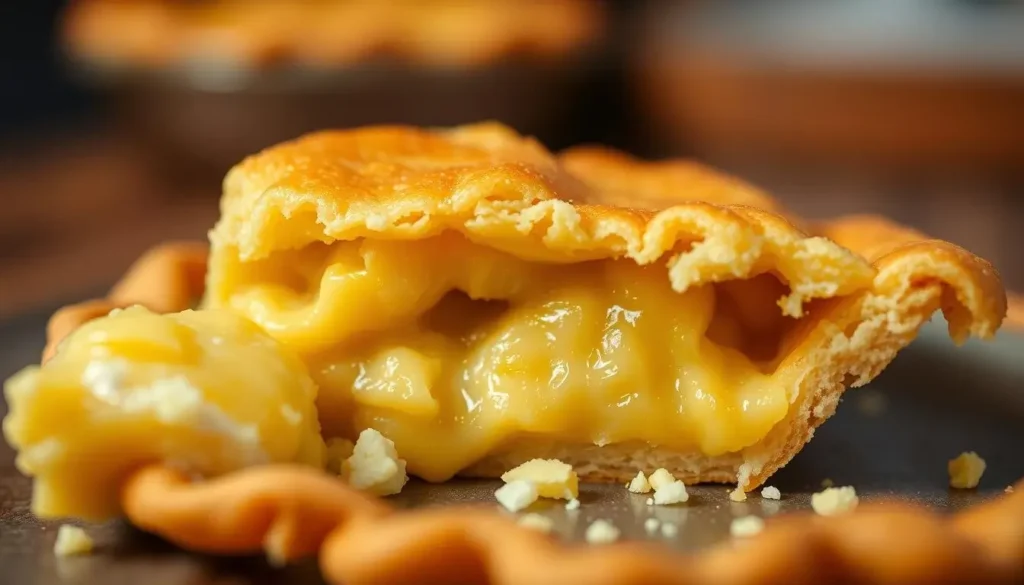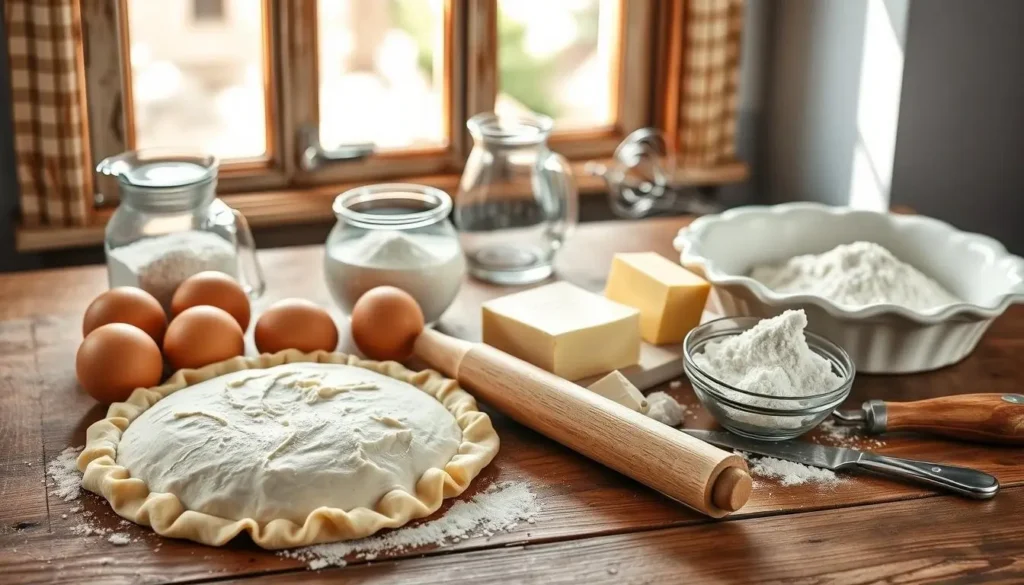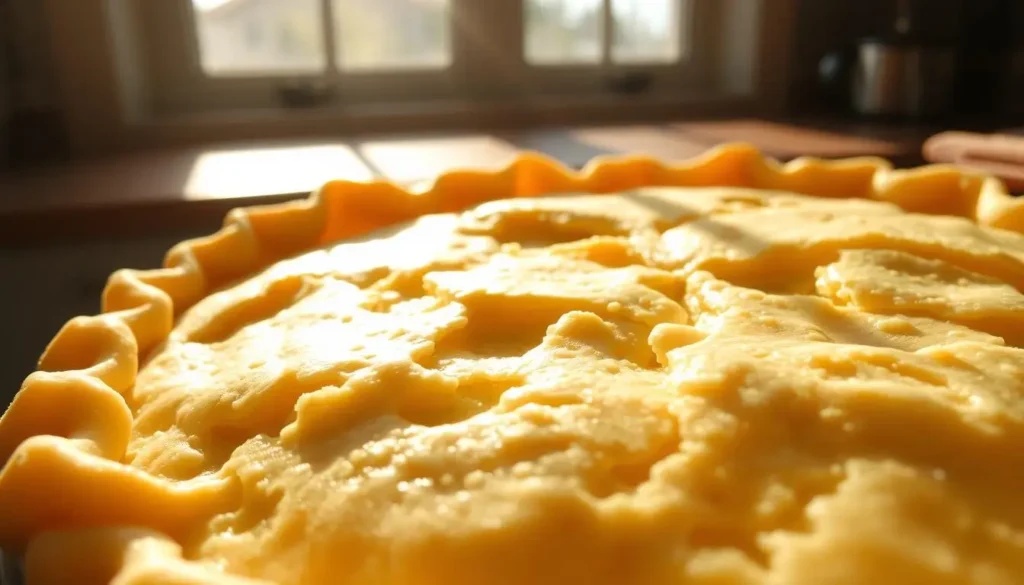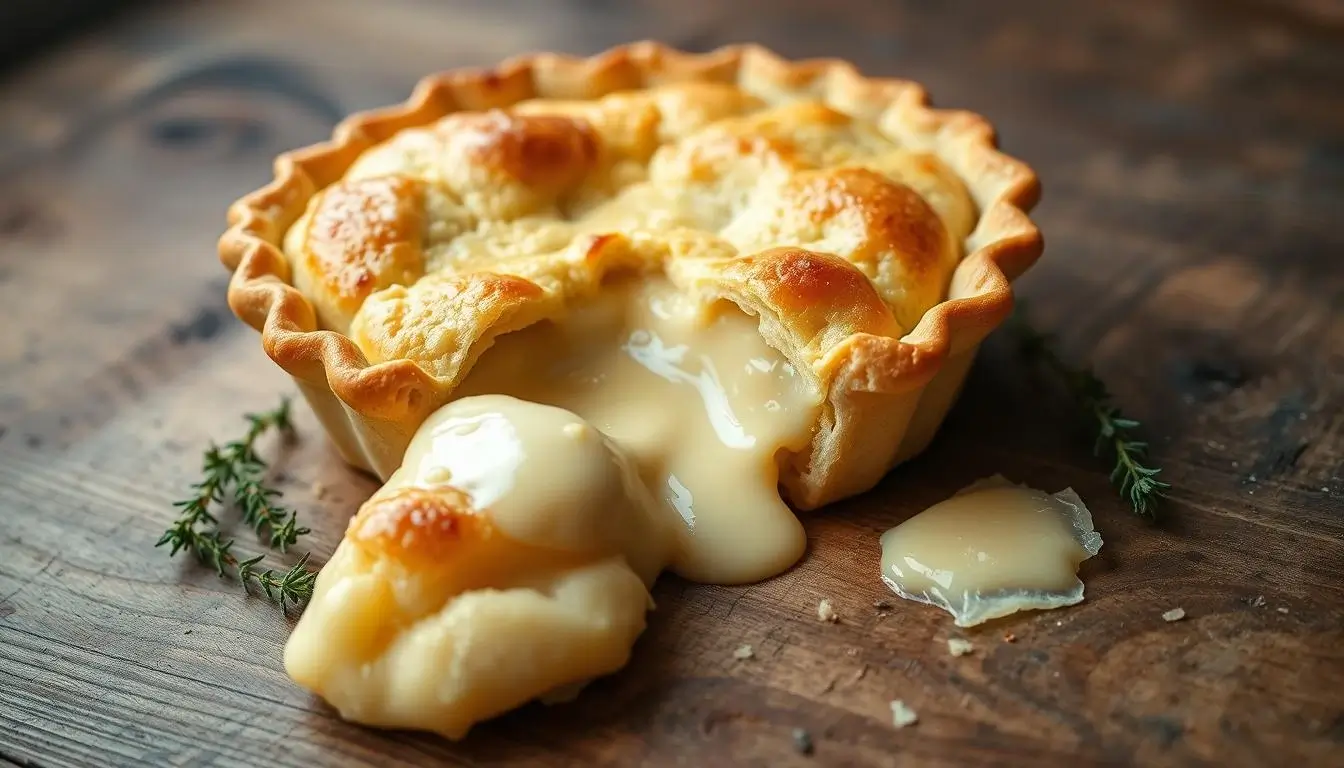Butter Pie: There’s something magical about the scent of golden pastry wafting through a cozy kitchen. Maybe it reminds you of your grandmother’s countertop, dusted with flour, or the joy of sharing a warm slice with loved ones on a chilly afternoon. This dessert isn’t just food—it’s a hug on a plate.
Today, we’ll craft a flaky, buttery crust paired with a velvety filling that melts on the tongue. You’ll learn how to blend simple ingredients like all-purpose flour and ice water into a perfect dough, then parbake it to crisp perfection. Every step matters, from chilling the pastry to layering the creamy center.
Regional variations of this treat date back generations, often tied to family traditions. Our version balances tradition with precision—think light brown sugar for depth and a pinch of salt to heighten flavors. Optional cranberries add a tart contrast, while whipped cream crowns each slice like snow on a winter morning.
Key Takeaways
- Master a flaky crust using cold unsalted butter and precise mixing techniques
- Parbake the base for 15–20 minutes to prevent a soggy bottom
- Explore the dessert’s historical roots and regional twists
- Use quality ingredients like kosher salt and fresh eggs for optimal texture
- Follow step-by-step guidance for foolproof results every time
Introduction to Homemade Butter Pie
The story of this dessert reads like a culinary love letter—layered with tradition and reinvented through generations. Its magic lies in contrasting textures: a crisp shell hugging a cloud-like center that dissolves on the tongue. Southern bakers perfected this balance, turning simple pantry staples into edible art.

Discovering the Allure of a Creamy Dessert
In Nashville, local chefs reimagined gooey butter bars as pies during the 1950s. The result? A cult classic where caramelized edges meet a custard-like heart.
“This dessert isn’t just sweet—it’s a time capsule of Southern ingenuity,”
says a third-generation baker from Tennessee.
You’ll notice how the flaky crust acts as both anchor and accent. Chilled dough made with ice water ensures structure, while the filling—a blend of eggs and sugar—bakes into silk. Regional twists, like adding bourbon or pecans, highlight its adaptability.
A Brief Look at Its Timeless Appeal
Families have passed down recipes for centuries, often scribbled on stained index cards. The secret? Precision. Too much flour toughens the base; undermixing creates gaps. But when done right, the golden top crackles like autumn leaves under a spoon.
Modern versions honor tradition while embracing shortcuts. Pre-measured ingredients save time, and parbaking prevents soggy bottoms. Yet the soul remains unchanged—a tribute to kitchens where laughter echoes and aprons collect memories.
Essential Tools and Ingredients for Your Pie
Every great dish begins with the right tools and ingredients—your butter pie is no exception. Gather these essentials to ensure your crust stays crisp and your filling sings with flavor.

Choosing the Right Flour, Butter, and More
Soft red winter wheat flour creates a lighter texture than all-purpose varieties. Its lower protein content prevents toughness. For the dough, use cold unsalted butter—it solidifies as it bakes, creating air pockets for flakiness.
Add ice water gradually. Too much makes the pastry sticky; too little causes cracks. Measure precisely: 1¼ cups flour and 8 tablespoons butter form the base. Optional cranberries? Fold ½ cup into the filling for tart contrast.
Understanding Measurements and Substitutions
Baking thrives on accuracy. Use measuring cups for dry items and a liquid cup for water. If swapping light brown sugar for white, reduce moisture by 1 tablespoon per cup.
- Salt swaps: ¼ tsp kosher salt = ½ tsp table salt
- Toolkit essentials: Sturdy mixing bowl, rolling pin, pie weights, digital scale
- Dough tips: Chill tools 15 minutes before use
Stick to authentic ingredients where possible. Imitation vanilla or margarine alters both taste and texture. Your effort deserves the real deal.
Crafting a Flaky Pie Crust
The foundation of any memorable dessert lies in its crust—crisp, layered, and golden. Master these techniques to transform basic ingredients into a textural masterpiece that cradles your filling with confidence.

Mixing Dry Ingredients and Incorporating Butter
Start by whisking 1½ cups flour with ½ teaspoon salt in a chilled bowl. Cut 10 tablespoons cold butter into pea-sized cubes. Sprinkle them over the dry mixture like confetti.
Use your fingertips to press each cube flat, creating irregular “leaves” that steam during baking. This creates air pockets for flakiness. Work quickly to prevent the butter from warming—cold is key.
Techniques for a Perfectly Crimped Edge
Add ice water one tablespoon at a time, mixing until the dough just clumps. Form it into a ball, wrap in plastic, and chill for 30 minutes. This rest period relaxes gluten for easier rolling.
Roll the dough to 12 inches on a floured surface. Gently lift it into your pan, pressing into corners without stretching. Trim excess, leaving a 1-inch overhang.
Fold the edges under themselves, then press with thumb and forefinger in a zigzag pattern. This crimp seals juices in and adds visual flair. Chill again before filling—patience rewards you with structure.
Mastering the Perfect Butter Pie
Achieving dessert perfection requires precision in both technique and timing. Let’s explore how to craft a luxurious filling and achieve that coveted golden finish.
Creating a Creamy, Indulgent Filling
Start by creaming ½ cup room-temperature butter with 1 cup light brown sugar. Mix until it resembles wet sand. This creates tiny air pockets for a silky texture.
Add ¼ tsp salt and 1 tsp vanilla extract. Crack 3 large eggs into a separate bowl, then incorporate them one at a time. Scrape the sides frequently to maintain consistency.
Pour the mixture into your chilled crust. Use a spatula to spread it evenly, leaving a ½-inch border. The filling will rise during baking but settle as it cools.
Baking Tips for a Golden, Puffy Top
Place the dessert on a sheet pan and bake at 350°F for 25–35 minutes. Watch for these visual cues:
| Stage | Appearance | Action |
|---|---|---|
| First 15 mins | Edges bubble lightly | Rotate pan |
| 20-25 mins | Center domes slightly | Check browning |
| Final 5 mins | Golden skin forms | Test with toothpick |
Cool completely before slicing—at least 1 hour. Serve chilled with whipped cream for contrast. The filling firms while staying creamy, like set custard.
Pro tip: If the top darkens too quickly, tent foil over the edges. This protects the crust while letting the center cook through.
Delicious Variations and Regional Inspirations
Across kitchens worldwide, humble ingredients transform into cultural icons through regional twists. Let’s explore two distinct takes that reimagine this classic dish—one decadently sweet, the other satisfyingly savory.
Gooey Butter Pie Inspirations from Nashville
Colt’s Candy Shop sparked a revolution in the 1950s by reshaping St. Louis-style gooey butter bars into pie form. Their version features a custard-like filling blended with cream cheese, crowned by caramelized pecans. The result? A textural symphony—silky center meets crunchy nut ribbons.
Exploring the Traditions of Lancashire Butter Pie
Born from Catholic fasting traditions, this British staple uses mashed potatoes and onions as its hearty base. A cornflour-enriched pastry gives the crust extra crispness—perfect for containing the steaming vegetable filling. Locals often pair it with tangy beetroot relish for balance.
- Nashville’s twist: 1 tsp vanilla extract + ½ cup chopped pecans
- Lancashire’s secret: Parboiled Maris Piper potatoes + chilled lard dough
Want to experiment? Swap pecans for dried cranberries in the sweet version, or try Yukon Gold potatoes for creamier texture in the savory recipe. Both styles prove how simple tweaks can honor history while creating new traditions.
Whether you crave sugar-dusted indulgence or earthy comfort, these regional gems showcase the dish’s remarkable versatility. Bake both to taste how culture shapes flavor.
Conclusion
Creating this dessert is a journey where patience meets creativity. Start with cold flour-based dough, rolled thin for a crisp foundation. Precise measurements—like chilled butter cubes and ice water—ensure your pie crust stays flaky, not tough.
Regional twists prove its versatility. Nashville’s gooey style leans into caramelized edges, while Lancashire’s savory version uses potatoes. Both honor tradition but invite personal flair. Swap nuts for spices or try alternative flours if inspired.
Every step matters. Parbake the shell to avoid sogginess. Let the filling cool fully before slicing—texture improves as it sets. Share your adaptations online; food communities thrive on shared innovation.
Mastering this pastry blends science with art. Whether following the classic pie crust method or experimenting, each bite celebrates homemade care. Now preheat your oven—your kitchen awaits its next delicious chapter. I think you will love this recipe too.
Can You Prep Sweet Breakfast Recipes Ahead of Time? Learn 5 Smart Storage Tricks
FAQ
Can I use salted butter instead of unsalted in the crust?
Yes, but reduce added salt by ¼ teaspoon to balance flavor. For best results, unsalted varieties let you control sodium levels precisely.
How do I prevent the bottom crust from getting soggy?
Pre-bake the crust for 10–12 minutes at 375°F before adding filling. A hot oven seals layers, creating a crisp barrier against moisture.
What’s the difference between Nashville-style and Lancashire versions?
Nashville gooey butter pie leans sweeter with cream cheese, while Lancashire’s savory recipe features potatoes and onions—a nod to its British roots.
How long should I refrigerate the dough before rolling?
Chill it for at least 30 minutes. This relaxes gluten, making the pastry easier to shape while ensuring flakiness during baking.
Can I prepare the dessert ahead of time?
Absolutely. Assemble and freeze unbaked for up to 3 months. Thaw overnight before baking, or add 5–7 minutes to cooking time.
Why isn’t my filling setting properly?
Undercooking or insufficient eggs can cause runniness. Bake until the center reaches 165°F and let it cool completely before slicing.
What flour works best for a tender crust?
All-purpose flour strikes the ideal balance. Avoid overmixing—pea-sized butter chunks create steam pockets for lift.
How do I achieve a glossy, golden top?
Brush the crust with an egg wash (1 egg + 1 tbsp water) before baking. This adds shine and promotes even browning.

